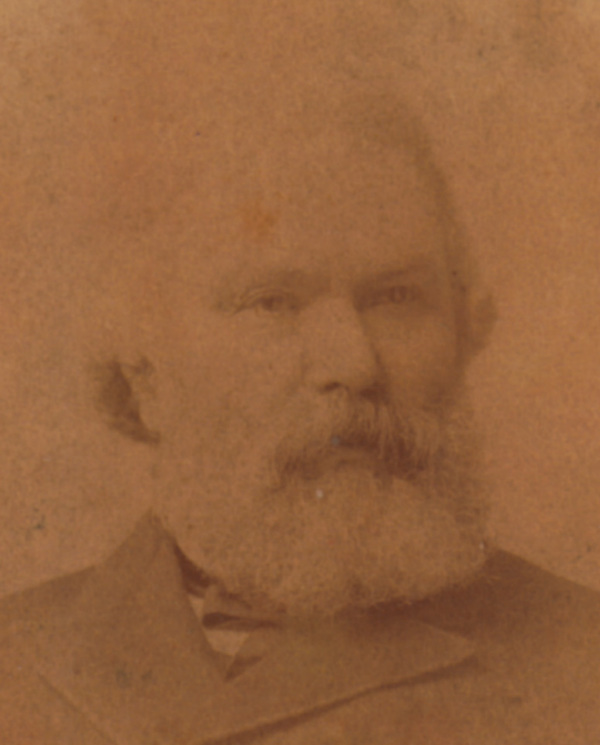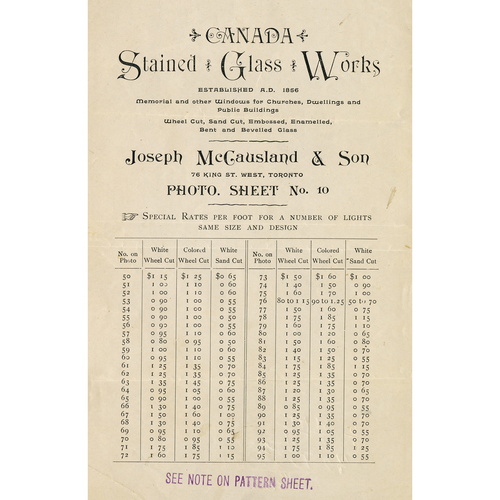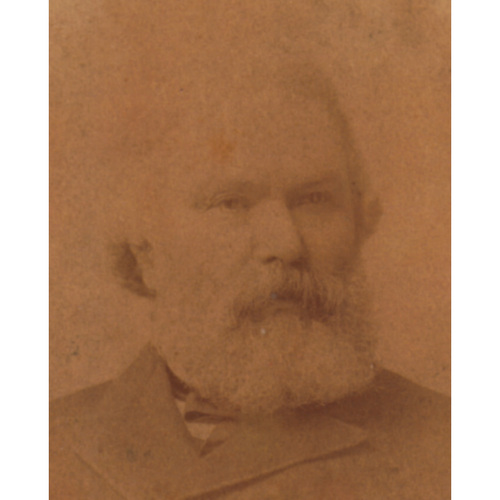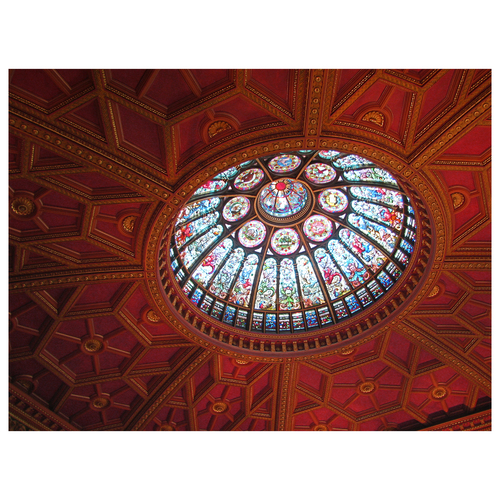
Source: Link
McCAUSLAND, JOSEPH, painter, decorator, and designer and manufacturer of stained-glass windows; b. 10 Feb. 1828 in County Armagh (Northern Ireland), son of Robert McCausland, a labourer, and Mary Jackson; m. first 1850 Elizabeth Key (d. 1876) in Toronto; m. secondly 23 April 1878 Martha Heas, widow of the Reverend James Boyse, in Raleigh Township, Ont.; he had eight daughters and four sons; d. 3 May 1905 in Toronto.
Joseph McCausland immigrated to Upper Canada with his family when he was 7. Educated and trained in Toronto, he was a practising artisan by the age of 11: in 1839 he supplied a receipt for $41.40 for painting, “graining, marbling & varnishing,” and “frosting glass imitation of ground glass.” In 1846 he established his own painting firm, which, during the period 1850–56, was located on Temperance Street; latterly he formed a brief partnership with William Bullock, listed as “McCausland & Bullock, glass stainers” at the same address. From 1862 the firm was called the Canada Stained Glass Works.
The surprising number, and sometimes size, of colonial churches built around mid century must have encouraged McCausland to think that his enterprise might flourish. There was still, however, a heavy reliance on British expertise. Architects Frederic William Cumberland* and Thomas Ridout had been obliged to various English glaziers for suggestions about coloured and stained glass for their cathedral church of St James in Toronto in 1850–52. Virtually every window in the cathedral begun by Frank Wills* at Fredericton was filled with stained glass from Britain when it was completed in the same years. Consequently, it was noteworthy that, when William Hay* added parochial schools to the Church of the Holy Trinity in Toronto in 1856, a tapestry-like window with ecclesiastical motifs in compatible Gothic Revival style was credited to Bullock – and presumably McCausland. The contemporary window of the evangelists in the church’s chancel was designed by Hay and executed by James Ballantine of Edinburgh; it provides a striking contrast to the Toronto window in its architectural character, monumental simplicity, and extensive and sonorous colour fields.
An especially large and early commission for McCausland and Bullock was a secular one, for Cumberland and William George Storm* at University College, in the University of Toronto, in 1858. Scores of coloured- and stained-glass windows were created, but only one example survives. It features golden crowns (from the arms of both the college and the university) on diamond-shaped panes within a green band, which is bordered by owls on ruby squares (for the college) alternating with rectangles of royal blue (the university’s colour). Perhaps it was a sample of these windows that won McCausland a prize for “Best specimen of Stained Glass” at the provincial exhibition that year. In any case the sheer quantity and the prominence of this work for University College must have helped to establish the young firm and secure its reputation.
Between 1862 and 1897 McCausland expanded every area of his business. There was further work at University College: a handsome armorial window of 1866 honoured three students killed in the Fenian engagement at Ridgeway [see Alfred Booker*] and was considered a great loss when destroyed by fire in 1890. Other public buildings having McCausland glass included Government House in Toronto, the Parliament Buildings in Ottawa, and the provincial legislature in Victoria. As home decorating prospered, McCausland executed residential projects throughout Ontario and Quebec. During the 1880s he could supply not only fashionable wallpapers from England, France, Germany, and the United States, but also matching frescos in plaster and papier mâché. Churches of all denominations, however, from St John’s to Vancouver Island, were the mainstay of the business. Though the bulk of production was destined for churches in Toronto, significant numbers of windows were commissioned for buildings throughout Ontario and the Maritimes. The range of his glass work was exceptionally broad: figures, flowers, fruits, coats of arms, and lettering on glass; shaped glass; and leaded and enamelled work for church decoration.
In 1881 McCausland’s eldest son, Robert, became a partner in the firm. Occupying four buildings on King Street West, Joseph McCausland and Son had from 70 to 100 employees; the rooms where glass was shaped and painted were never shown to outsiders. Before 1879 McCausland had engaged a succession of British-trained artists. His glass remained rich in colour into the 1880s and, when figural, it showed a striving for originality, as demonstrated by even the fragmentary King David, St Peter, and two angels (from five windows of the 1880s) that are to be found in Trinity College chapel, Toronto. Under the influence of English leaders in the field, such glass tended toward the delicacy of Edward Coley Burne-Jones’s work for William Morris, combined with the robustness of Henry Holiday.
Among McCausland’s commercial projects was the opulent skylight that still presides over the former Bank of Montreal at Yonge and Front in Toronto. The rich and emblematic character of much of his glass is evident in a description of this commission in 1886: “Cornucopia pour out in lavish fashion the gold and silver coin, which for centuries have been the emblem of the banker’s occupation. Dragons and mythical personages in blue and crimson draperies keep guard over these treasures and defy ‘the gorgons and chimaeras dire’, which from other portions of the dome would ravish them away. The outer panel bears festoons of fruit and flowers, while in the centre are eight circles bearing emblems of the eight provinces of the Dominion.”
The stained-glass department of McCausland’s firm was made a separate company under Robert in 1897, despite Joseph’s initial inclination to give up that branch and his misgivings about Robert’s business ability. The general painting and decorating business passed to another son, Frank Herbert, who would serve as president of the firm from 1901 to 1940. The best-known McCausland work is undoubtedly the large window on the stairs opposite the entrance in Toronto’s third City Hall, by architect Edward James Lennox*. This commission, in fact, was the first to come to Robert on his own in 1897. Although the individual contributions of father and son before that date cannot be easily distinguished, the former was unquestionably a most important figure for his time. The medals won at provincial exhibitions from 1858, at the Colonial and Indian Exhibition in London in 1886, and at the Columbian exposition in Chicago in 1893 suggest contemporary estimates of the work of Joseph’s firm over more than three decades.
In religion McCausland’s parents had belonged to the Church of Ireland, but Joseph became a Methodist before he turned 15. In Toronto he was a member successively of the Bay Street Church, the Alice Street Church, and the Canton Street Church, of which he was a trustee and a class leader for 30 years. In politics he was a Liberal. McCausland died in 1905 at his home at 18 Wood Street.
AO, RG 22, ser.305, no.17893; RG 80-5, no.1878-004577. CTA, RG 5, F, St Andrew’s Ward, 1853–55. NA, RG 31, C1, 1842, Toronto, St George’s Ward. Private arch., McCausland family, McCausland letter-books, 1895–97, 1900–1; McCausland scrapbooks, I–II. Toronto Necropolis and Crematorium, Burial records and tombstone inscriptions, lots O-91–98. Globe, 18 Oct., 17 Nov. 1866; 4 May 1905; 23 July 1923. Toronto Daily Star, 4 May 1905. World (Toronto), 4 May 1905. Canadian Architect, 12 (1899): 177 and photograph facing p.190. William Dendy et al., Toronto observed: its architecture, patrons, and history (Toronto, 1986). Directories, Can., Prov. of, 1857/58; Toronto, 1843/44–77. Alice Hamilton and Corey Keeble, “McCausland stained glass” (typescript, 1985; copies in possession of Kenneth Hamilton, Winnipeg, and Corey Keeble, Toronto); “Saints and angels, kings and prophets: stained glass in Trinity College, University of Toronto,” Canadian Collector (Toronto), 16 (1981), no.6: 47–52. Alice Hamilton et al., Manitoban stained glass ([Winnipeg], 1970). Douglas Richardson et al., A not unsightly building: University College and its history (Toronto and Oakville, Ont., 1990). Studio (New York), 1887–88. U.C., Board of Agriculture and Agricultural Assoc., Trans. (Toronto), 3 (1858–59): 198. [G. P. Ure], The hand-book of Toronto . . . by a member of the press (Toronto, 1858), 257–59, 269.
Cite This Article
Alice Hamilton and Douglas Richardson, “McCAUSLAND, JOSEPH,” in Dictionary of Canadian Biography, vol. 13, University of Toronto/Université Laval, 2003–, accessed December 12, 2025, https://www.biographi.ca/en/bio/mccausland_joseph_13E.html.
The citation above shows the format for footnotes and endnotes according to the Chicago manual of style (16th edition). Information to be used in other citation formats:
| Permalink: | https://www.biographi.ca/en/bio/mccausland_joseph_13E.html |
| Author of Article: | Alice Hamilton and Douglas Richardson |
| Title of Article: | McCAUSLAND, JOSEPH |
| Publication Name: | Dictionary of Canadian Biography, vol. 13 |
| Publisher: | University of Toronto/Université Laval |
| Year of publication: | 1994 |
| Year of revision: | 1994 |
| Access Date: | December 12, 2025 |






